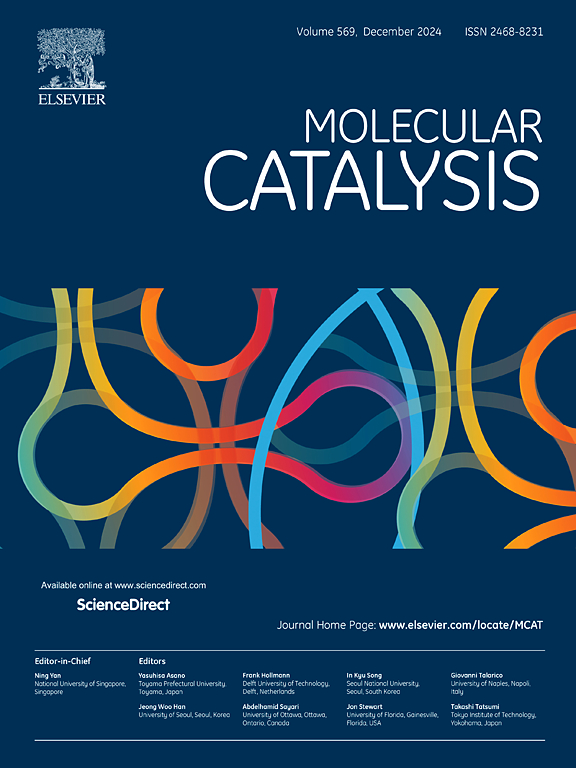Pd nanoparticles immobilized by a MOF-derived CeO2/C for boosting ethylene glycol electrooxidation
IF 3.9
2区 化学
Q2 CHEMISTRY, PHYSICAL
引用次数: 0
Abstract
The operation of direct ethylene glycol fuel cells (DEGFCs) to generate electric energy from ethylene glycol rely on the effective electrocatalysts for the ethylene glycol oxidation reaction (EGOR). The fabrication of EGOR electrocatalysts with high activity, high durability and high resistance for corrosion, is essential important for the DEGFCs. Herein, we report a fabrication of Pd nanoparticles immobilized by the Ce-doped ZIF-67-derived carbon (Pd-CeO2/ZDC). The Pd nanoparticles are generated by the in-situ reduction reaction between the H2PdCl4 and the Co nanoparticles formed during the ZIF-67 pyrolysis. Owe to the porous structure and N-doping inherited from the ZIF-67, the Pd and CeO2 nanoparticles show a uniform distribution. Due to the enhanced EGOR electrooxidation kinetic promoted by the ZIF-67-derived support, the multiple-components and structure synergies, the resultant Pd-CeO2/ZDC catalyst affords a EGOR current density of 32.4 mA cm-2, which is higher than the commercial Pd/C as well as the counterpart Pd/ZDC catalyst without CeO2. Furthermore, the Pd-CeO2/ZDC catalyst also present a better EGOR durability. This work provides a strategy for the design of EGOR catalyst with multiple-components and desired structure, which may inspire the new tactics for controllable design and synthesis of other electrocatalysts for various electrocatalysis.

利用 MOF 衍生的 CeO2/C 固定钯纳米颗粒促进乙二醇电氧化
利用乙二醇产生电能的直接乙二醇燃料电池(DEGFC)的运行依赖于乙二醇氧化反应(EGOR)的有效电催化剂。制备具有高活性、高耐久性和高耐腐蚀性的乙二醇氧化反应电催化剂对 DEGFCs 至关重要。在此,我们报告了用掺杂铈的 ZIF-67 衍生碳(Pd-CeO2/ZDC)固定钯纳米粒子的制备方法。钯纳米颗粒是由 H2PdCl4 与 ZIF-67 热解过程中形成的 Co 纳米颗粒发生原位还原反应生成的。由于 ZIF-67 的多孔结构和 N 掺杂,钯和 CeO2 纳米粒子呈现均匀分布。由于 ZIF-67 衍生载体促进了 EGOR 电氧化动力学的增强,以及多组分和结构的协同作用,所生成的 Pd-CeO2/ZDC 催化剂的 EGOR 电流密度为 32.4 mA cm-2,高于商用 Pd/C 催化剂和不含 CeO2 的 Pd/ZDC 催化剂。此外,Pd-CeO2/ZDC 催化剂还具有更好的 EGOR 耐久性。这项工作为设计具有多组分和理想结构的 EGOR 催化剂提供了一种策略,可为可控设计和合成用于各种电催化的其他电催化剂提供新的启发。
本文章由计算机程序翻译,如有差异,请以英文原文为准。
求助全文
约1分钟内获得全文
求助全文
来源期刊

Molecular Catalysis
Chemical Engineering-Process Chemistry and Technology
CiteScore
6.90
自引率
10.90%
发文量
700
审稿时长
40 days
期刊介绍:
Molecular Catalysis publishes full papers that are original, rigorous, and scholarly contributions examining the molecular and atomic aspects of catalytic activation and reaction mechanisms. The fields covered are:
Heterogeneous catalysis including immobilized molecular catalysts
Homogeneous catalysis including organocatalysis, organometallic catalysis and biocatalysis
Photo- and electrochemistry
Theoretical aspects of catalysis analyzed by computational methods
文献相关原料
公司名称
产品信息
麦克林
Ce(NO3)3?6H2O
麦克林
PdCl2
麦克林
NaBH4
阿拉丁
Co(NO3)3?6H2O
阿拉丁
2-methylimidazole
 求助内容:
求助内容: 应助结果提醒方式:
应助结果提醒方式:


